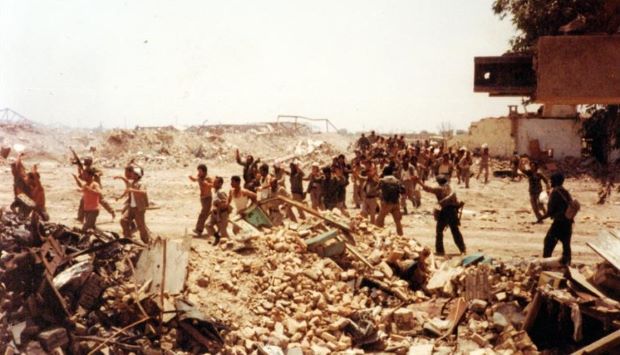The armed conflict between Iran and Iraq that lasted from September 22, 1980, ended on this day in 1988 when both sides accepted the United Nations Security Council Resolution 598.
Active hostilities began with the Iraqi invasion of Iran, the primary rationale cited as being the need to prevent Ruhollah Khomeini—who had spearheaded the Iranian Revolution in 1979—from exporting the new Iranian ideology to Iraq. There were also fears among the Iraqi leadership of Saddam Hussein that Iran, a theocratic state with a population predominantly composed of Shia Muslims, would exploit sectarian tensions in Iraq by rallying Iraq’s Shia majority against the Baʽathist government, which was officially secular and dominated by Sunni Muslims. Iraq also wished to replace Iran as the power player in the Persian Gulf, which was not seen as an achievable objective prior to the Islamic Revolution because of Pahlavi Iran‘s economic and military superiority as well as its close relationships with the United States and Israel.
The Iran–Iraq War followed a long-running history of territorial border disputes between the two states, as a result of which Iraq planned to retake the eastern bank of the Shatt al-Arab that it had ceded to Iran in the 1975 Algiers Agreement. Iraqi support for Arab separatists in Iran increased following the outbreak of hostilities; Saddam disputedly may have wished to annex Iran’s Arab-majority Khuzestan province.
While the Iraqi leadership had hoped to take advantage of Iran’s post-revolutionary chaos and expected a decisive victory in the face of a severely weakened Iran, the Iraqi military only made progress for three months, and by December 1980, the Iraqi invasion had stalled. The Iranian military began to gain momentum against the Iraqis and regained all lost territory by June 1982. After pushing Iraqi forces back to the pre-war border lines, Iran rejected United Nations Security Council Resolution 514 and launched an invasion of Iraq. The subsequent Iranian offensive within Iraqi territory lasted for five years, with Iraq taking back the initiative in mid-1988 and subsequently launching a series of major counter-offensives that ultimately led to the conclusion of the war in a stalemate.
The eight years of war exhaustion, economic devastation, decreased morale, military stalemate, inaction by the international community towards the use of weapons of mass destruction by Iraqi forces on Iranian soldiers and civilians, as well as increasing Iran–United States military tensions all culminated in Iran’s acceptance of a ceasefire brokered by the United Nations Security Council. In total, around 500,000 people were killed during the Iran–Iraq War, with Iran bearing the larger share of the casualties, excluding the tens of thousands of civilians killed in the concurrent Anfal campaign that targeted Iraqi Kurdistan. The end of the conflict resulted in neither reparations nor border changes, and the combined financial losses suffered by both combatants are believed to have exceeded US$1 trillion.
-Wikipedia
Photo Caption – In re-taking Khorramshahr, the Iranians captured some 19,000 soldiers from a demoralized Iraqi Army in 1982 –Wikipedia



Comments are closed, but trackbacks and pingbacks are open.